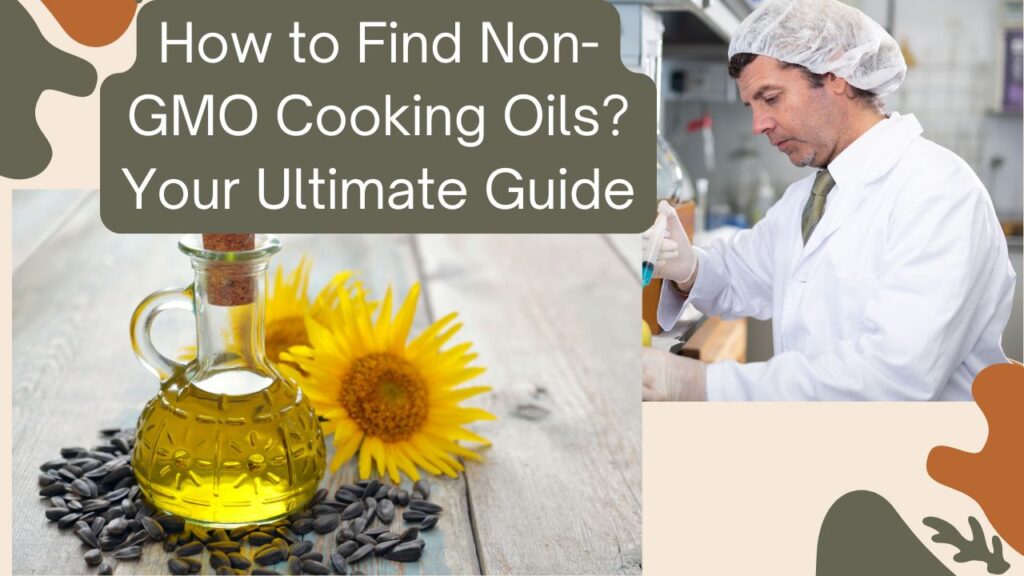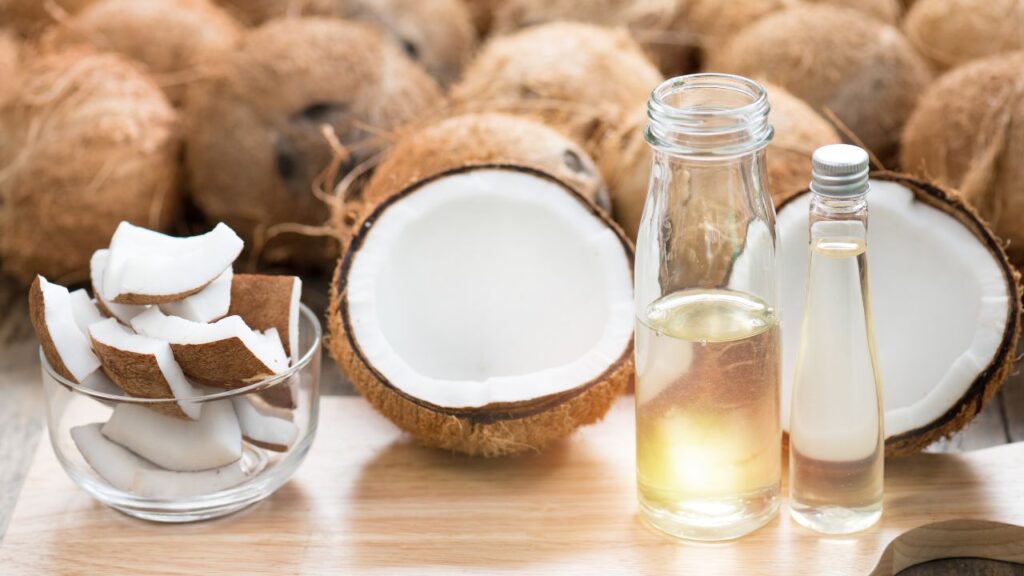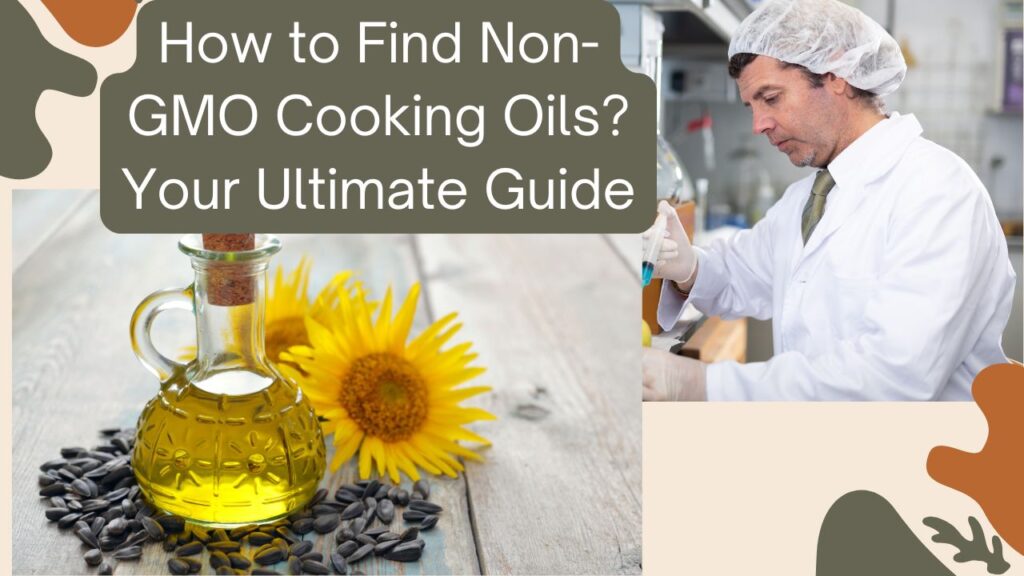
Did you know that over 90% of soybean oil in the U.S. is genetically modified? How to find non-GMO cooking oils is a question many health-conscious individuals and culinary enthusiasts grapple with today. With the growing awareness of genetically modified organisms (GMOs) and their impact on health and the environment, choosing non-GMO cooking oils has become more important than ever. Whether you’re a seasoned home cook or just starting your culinary journey, understanding how to identify and select non-GMO cooking oils can significantly enhance your dietary choices and support sustainable farming practices. Let’s explore the world of non-GMO cooking oils and how you can make informed decisions in your kitchen.
Contents
- 1 Understanding GMOs in Cooking Oils
- 2 Benefits of Choosing Non-GMO Cooking Oils
- 3 How to Identify Non-GMO Cooking Oils
- 4 Where to Buy Non-GMO Cooking Oils
- 5 Top Non-GMO Cooking Oils to Consider
- 6 Practical Tips for Choosing Non-GMO Cooking Oils
- 7 Comparing Different Cooking Oils Using Their Labels
- 8 Step-by-Step Guide to Finding Non-GMO Cooking Oils
- 9 Frequently Asked Questions (FAQs)
- 10 Conclusion
Understanding GMOs in Cooking Oils
What are GMOs?
Genetically modified organisms (GMOs) are plants, animals, or microorganisms whose genetic makeup has been altered in ways that do not occur naturally through mating or natural recombination. In the context of cooking oils, GMOs are primarily found in crops like soybeans, canola, and corn, which are genetically engineered for traits such as pest resistance and increased yield.
How GMOs are Used in Cooking Oil Production
GMOs play a significant role in the production of many cooking oils. For instance:
- Soybean Oil: Most soybean crops are genetically modified to resist herbicides, making soybean oil one of the most common GMO oils.
- Canola Oil: Similarly, a large percentage of canola crops are genetically engineered for better resistance to pests and herbicides.
- Corn Oil: Genetically modified corn is used to produce corn oil, often favored for its neutral flavor and high smoke point.
Health and Environmental Concerns
The use of GMOs in cooking oil production raises several health and environmental concerns:
- Health Risks: While research on GMOs is ongoing, some studies suggest potential long-term health effects, including allergic reactions and antibiotic resistance.
- Environmental Impact: GMO farming practices can lead to reduced biodiversity, increased use of herbicides, and the development of resistant pests, disrupting natural ecosystems.
Benefits of Choosing Non-GMO Cooking Oils
Health Benefits
Opting for non-GMO cooking oils offers numerous health advantages:
- Reduced Exposure to GMOs: Minimizing intake of genetically modified ingredients can reduce potential health risks associated with GMOs.
- Fewer Pesticides and Chemicals: Non-GMO oils often come from organically grown crops, which are cultivated without synthetic pesticides and fertilizers, leading to cleaner, safer oils.
Environmental Benefits
Choosing non-GMO cooking oils supports environmental sustainability:
- Support for Sustainable Farming: Non-GMO farming practices promote biodiversity and reduce reliance on chemical herbicides and pesticides.
- Preservation of Ecosystems: By avoiding genetically modified crops, you help protect natural ecosystems from the adverse effects of GMO farming, such as soil degradation and water contamination.
Ethical Considerations
Selecting non-GMO cooking oils aligns with ethical consumerism:
- Transparency and Integrity: Non-GMO oils often come from producers who prioritize transparency in their farming and production processes.
- Fair Trade Practices: Many non-GMO oil brands adhere to fair trade principles, ensuring fair wages and sustainable practices for farmers.
How to Identify Non-GMO Cooking Oils
Reading Labels
The first step in finding non-GMO cooking oils is learning how to read and interpret labels effectively:
- Key Phrases: Look for phrases like “Non-GMO Project Verified,” “100% Non-GMO,” or “Made with Non-GMO Ingredients.”
- Certification Logos: The Non-GMO Project seal is a reliable indicator that the product has been verified as non-GMO.
Certifications and Standards
Certifications can provide assurance of a product’s non-GMO status:
- Non-GMO Project Verified: This certification ensures that the cooking oil has been tested and verified to be free from GMOs.
- USDA Organic: While organic does not always mean non-GMO, most organic products are also non-GMO, as organic standards prohibit the use of GMOs.
Ingredient Lists
Examining the ingredient list is crucial for identifying non-GMO oils:
- Pure Oils: Ensure that the ingredient list contains only one ingredient, such as “Extra Virgin Olive Oil” or “Cold-Pressed Avocado Oil.
- Blended Oils: If the oil is a blend, check that all listed oils are non-GMO. Avoid oils with added preservatives or artificial flavorings unless they are also non-GMO.
Trusted Brands and Products
Choosing reputable brands can simplify the search for non-GMO cooking oils:
- Reputable Brands: Brands like Bragg, Primal Kitchen, and Spectrum offer a range of non-GMO cooking oils.
- Transparency: Opt for brands that are transparent about their sourcing and production methods, providing clear information about their non-GMO practices.
Where to Buy Non-GMO Cooking Oils
Grocery Stores
Most major grocery stores now carry a variety of non-GMO cooking oils:
- Organic Sections: Check the organic or health food sections, where non-GMO oils are often prominently displayed.
- Specialty Aisles: Look for specialty aisles dedicated to health-conscious and organic products.
Health Food Stores
Health food stores are excellent places to find a wide selection of non-GMO cooking oils:
- Extensive Selection: These stores typically offer a broader range of non-GMO and organic oils compared to regular grocery stores.
- Expert Assistance: Staff in health food stores are often knowledgeable and can help you find the best non-GMO options.
Online Retailers
Shopping online provides access to a vast array of non-GMO cooking oils:
- Top Websites: Platforms like Amazon, Thrive Market, and Vitacost offer numerous non-GMO cooking oil options.
- Convenience: Buying online allows you to compare different products, read reviews, and choose the best option for your needs from the comfort of your home.
Farmers’ Markets and Local Producers
Supporting local producers can ensure you’re getting fresh, non-GMO cooking oils:
- Local and Small-Scale Producers: Farmers’ markets often feature local producers who use non-GMO farming practices.
- Freshness and Quality: Purchasing directly from producers can guarantee the freshness and quality of the oils you buy.
Top Non-GMO Cooking Oils to Consider
Extra Virgin Olive Oil
Key Features:
- Certification: Look for “Extra Virgin” and “Non-GMO Project Verified.”
- Best Uses: Ideal for salad dressings, sautéing, and low-heat cooking.
- Health Benefits: High in monounsaturated fats and antioxidants, promoting heart health.
Avocado Oil
Key Features:
- High Smoke Point: Suitable for high-heat cooking like grilling and frying.
- Flavor: Mild, buttery flavor that complements a variety of dishes.
- Health Benefits: Rich in monounsaturated fats and vitamin E, supporting skin and heart health.

Coconut Oil
Key Features:
- Varieties: Choose unrefined or virgin coconut oil for non-GMO options.
- Best Uses: Perfect for baking, frying, and adding a tropical flavor to dishes.
- Health Benefits: Contains medium-chain triglycerides (MCTs) that boost metabolism and have antimicrobial properties.
Canola Oil
Key Features:
- Non-GMO Certified: Ensure the label specifies “Non-GMO.”
- Best Uses: Versatile oil suitable for general cooking, baking, and frying.
- Health Benefits: Low in saturated fats and contains omega-3 fatty acids, supporting heart health.
Sunflower Oil
Key Features:
- High-Oleic Varieties: Opt for high-oleic sunflower oil for better heart health benefits.
- Best Uses: Great for frying, baking, and salad dressings.
- Health Benefits: High in vitamin E and polyunsaturated fats, promoting healthy skin and reducing inflammation.
Comparison of Popular Non-GMO Cooking Oils
| Cooking Oil | Key Features | Best Uses | Health Benefits |
|---|---|---|---|
| Olive Oil | Extra virgin, cold-pressed, Non-GMO | Salad dressings, sautéing | High in monounsaturated fats, antioxidants |
| Avocado Oil | High smoke point, Non-GMO, rich flavor | Grilling, frying, baking | Rich in monounsaturated fats, vitamin E |
| Coconut Oil | Unrefined/virgin options, Non-GMO | Baking, frying, tropical dishes | Contains MCTs, antimicrobial properties |
| Canola Oil | Non-GMO certified, light flavor | General cooking, baking | Low in saturated fats, contains omega-3s |
| Sunflower Oil | High-oleic variants, Non-GMO | Frying, baking, dressings | High in vitamin E, polyunsaturated fats |
Practical Tips for Choosing Non-GMO Cooking Oils
Match Oil to Cooking Method
Different oils are suited to different cooking methods based on their smoke points and flavor profiles:
- High-Heat Cooking (Frying, Sautéing): Use oils with high smoke points like avocado oil or refined olive oil.
- Low-Heat Cooking (Dressings, Light Sautéing): Extra virgin olive oil or flaxseed oil are ideal.
- Baking: Neutral oils like canola oil or sunflower oil work well.
Balance Between Different Fats
Incorporate a variety of healthy fats into your diet by choosing different oils for different purposes. This ensures you receive a balanced intake of monounsaturated, polyunsaturated, and essential fatty acids.
Avoiding Unhealthy Additives
Steer clear of oils with trans fats, excessive preservatives, or artificial flavorings. Opt for pure, minimally processed oils to maximize health benefits and natural flavors.
Reading Labels Quickly and Effectively
- Scan for Certifications: Look for “Non-GMO Project Verified” and other relevant certifications.
- Check Fat Composition: Ensure a higher proportion of monounsaturated and polyunsaturated fats.
- Identify Additives: Avoid oils with unnecessary additives or preservatives.
- Assess Smoke Point: Match the oil’s smoke point to your cooking needs.
Comparing Different Cooking Oils Using Their Labels
Steps for Reading Cooking Oil Labels
| Step | Description |
|---|---|
| 1. Identify the Type of Oil | Determine if it’s extra virgin, virgin, or refined based on the label. |
| 2. Check the Serving Size | Understand the portion size to accurately assess nutritional information. |
| 3. Analyze the Fat Content | Look at the breakdown of saturated, monounsaturated, and polyunsaturated fats. |
| 4. Review Ingredients | Ensure the oil is pure or understand the components in blended oils. |
| 5. Look for Certifications | Identify any organic, non-GMO, or other quality certifications. |
| 6. Examine Additional Info | Note the smoke point, shelf life, and storage instructions. |
Popular Non-GMO Cooking Oils and Their Label Features
| Cooking Oil | Key Label Features | Best Uses | Health Benefits |
|---|---|---|---|
| Olive Oil | Extra Virgin, Cold-Pressed | Salad dressings, sautéing | High in monounsaturated fats, antioxidants |
| Avocado Oil | High Smoke Point, Non-GMO, Rich Flavor | Grilling, frying, baking | Rich in monounsaturated fats, vitamin E |
| Coconut Oil | Virgin vs. Refined, Organic options | Baking, frying, cooking | Contains MCTs, antimicrobial properties |
| Canola Oil | Non-GMO Certified, Light Flavor | General cooking, baking | Low in saturated fats, contains omega-3s |
| Sunflower Oil | High-Oleic, Organic options | Frying, baking, dressings | High in vitamin E, polyunsaturated fats |
Step-by-Step Guide to Finding Non-GMO Cooking Oils
Step 1: Research and Education
Start by understanding what GMOs are and how they are used in cooking oil production. Familiarize yourself with the potential health and environmental impacts associated with GMOs to appreciate the importance of choosing non-GMO oils.

Step 2: Label Inspection
When shopping, thoroughly inspect labels for non-GMO indicators. Look for phrases like “Non-GMO Project Verified” and ensure the ingredient list contains only pure oils without unnecessary additives.
Step 3: Certification Verification
Verify certifications by checking official websites of certifying bodies like the Non-GMO Project or USDA Organic. This ensures that the labels are accurate and trustworthy.
Step 4: Choose Trusted Brands
Opt for brands known for their commitment to non-GMO and organic practices. Trusted brands often provide clear information about their sourcing and production methods, making it easier to select high-quality oils.
Step 5: Compare Prices
Finding high-quality non-GMO oils within your budget is possible by comparing prices across different retailers and considering bulk purchases or online deals. Remember, investing in good quality oils can pay off in terms of health benefits and flavor.
Step 6: Purchase
Buy from reliable retailers, whether in-store or online, ensuring that the product meets your non-GMO requirements. Check return policies and satisfaction guarantees when purchasing new brands.
Frequently Asked Questions (FAQs)
What are the best non-GMO cooking oils available?
Answer: Some of the top non-GMO cooking oils include extra virgin olive oil, avocado oil, non-GMO certified canola oil, and high-oleic sunflower oil. Brands like Bragg, Primal Kitchen, and Spectrum offer reliable non-GMO options.
How can I verify if a cooking oil is non-GMO?
Answer: Look for certifications like “Non-GMO Project Verified” on the label. Additionally, check the ingredient list for any GMO ingredients and verify certifications through official websites.
Are non-GMO cooking oils healthier than regular oils?
Answer: Non-GMO cooking oils are often considered healthier as they are free from genetically modified organisms and may contain fewer pesticides and chemicals. They also support sustainable and ethical farming practices.
Where can I buy non-GMO cooking oils locally?
Answer: Non-GMO cooking oils can be found at health food stores, organic sections of grocery stores, farmers’ markets, and online retailers like Amazon, Thrive Market, and specialized organic stores.
Do non-GMO cooking oils have different nutritional profiles?
Answer: The nutritional profiles of non-GMO cooking oils are similar to their GMO counterparts, focusing on healthy fats like monounsaturated and polyunsaturated fats. However, non-GMO oils may have fewer additives and preservatives.
Conclusion
Understanding how to find non-GMO cooking oils is essential for making informed and healthy choices in your kitchen. By paying attention to key label components like the type of oil, fat composition, ingredients, and certifications, you can select the best oils that align with your dietary needs and culinary preferences. Remember, a well-informed consumer is empowered to enhance both the flavor and nutritional value of their meals. Take the time to read and understand cooking oil labels, experiment with different oils, and enjoy the benefits of choosing high-quality, healthy fats for your daily cooking.

